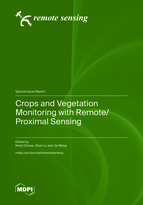Crops and Vegetation Monitoring with Remote/Proximal Sensing
A special issue of Remote Sensing (ISSN 2072-4292). This special issue belongs to the section "Remote Sensing in Agriculture and Vegetation".
Deadline for manuscript submissions: closed (15 April 2023) | Viewed by 28476
Special Issue Editors
Interests: remote sensing; plant phenotyping; agricultural informatics; environmental plant science; global environmental science
Special Issues, Collections and Topics in MDPI journals
Interests: vegetation remote sensing; biophysical parameter retrieval; multi-angle reflectance; polarized remote sensing; hyperspectral remote sensing
Special Issues, Collections and Topics in MDPI journals
Interests: land use land cover change; ecological remote sensing; agricultural remote sensing; drylands
Special Issues, Collections and Topics in MDPI journals
Special Issue Information
Dear Colleagues,
Remote and proximal sensing are exceedingly powerful techniques for characterizing and monitoring crop or vegetation properties at reasonable temporal and spatial resolutions. Remote sensing uses airborne and spaceborne platforms to collect muti- and hyperspectral imagery, and is widely applied for the vegetation monitoring of large-scale interest with respect to the effect of geophysical and climate parameters. In contrast, proximal sensing using various types of sensors mounted on static, mobile and unmanned aerial vehicle (UAV) platforms can supply functional and structural information for smart agriculture and plant phenotyping, as well as detailed ground information for mechanism analysis in agricultural land, grassland and forest ecosystems.
The aim of this Special Issue is to develop crop or vegetation monitoring via various remote or proximal sensing techniques ranging from the individual plant to the global level using various types of sensors mounted on static, mobile, UAV, aircraft and satellite platforms. The used sensors include handheld spectrometers, color cameras, multispectral and hyperspectral imaging systems, thermographic cameras, lidars and microwave radiometers.
This Special Issue, “Crops and Vegetation Monitoring with Remote/Proximal Sensing”, encourages discussion concerning innovative techniques/approaches based on the various types of remote sensing data, remote or proximal, to monitor crop and vegetation properties, including plant phenotyping, smart agriculture, vegetation mapping, biophysical or biochemical parameter estimation or inversion, health, and productivity in various ecosystems at different spatial and temporal scales.
Prof. Dr. Kenji Omasa
Prof. Dr. Shan Lu
Prof. Dr. Jie Wang
Guest Editors
Manuscript Submission Information
Manuscripts should be submitted online at www.mdpi.com by registering and logging in to this website. Once you are registered, click here to go to the submission form. Manuscripts can be submitted until the deadline. All submissions that pass pre-check are peer-reviewed. Accepted papers will be published continuously in the journal (as soon as accepted) and will be listed together on the special issue website. Research articles, review articles as well as short communications are invited. For planned papers, a title and short abstract (about 100 words) can be sent to the Editorial Office for announcement on this website.
Submitted manuscripts should not have been published previously, nor be under consideration for publication elsewhere (except conference proceedings papers). All manuscripts are thoroughly refereed through a single-blind peer-review process. A guide for authors and other relevant information for submission of manuscripts is available on the Instructions for Authors page. Remote Sensing is an international peer-reviewed open access semimonthly journal published by MDPI.
Please visit the Instructions for Authors page before submitting a manuscript. The Article Processing Charge (APC) for publication in this open access journal is 2700 CHF (Swiss Francs). Submitted papers should be well formatted and use good English. Authors may use MDPI's English editing service prior to publication or during author revisions.
Keywords
- crop monitoring
- forest monitoring
- smart agriculture
- vegetation phenology
- chlorophyll fluorescence of vegetation
- biophysical parameters retrieval
- grassland remote sensing
- vegetation remote sensing
- observation techniques of in situ measurements, eddy covariance, UAV, and satellites
- vegetation health








